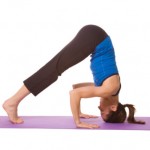By Dr. Paul Jerard, E-RYT 500, YACEP

What is the importance of selecting the right clothing for Yoga? Around the world, specialization is taken very seriously. We research kitchen implements, yard treatments, and educational toys for babies before we buy them, to ensure we are getting the perfect tool for the job at hand. Sometimes we are discouraged from trying a new activity, because we don’t have all the right “gear” for it.
This does not need to be the case with clothing for Yoga, however. In general, if you have exercise clothes for aerobics or stretching exercises of any kind, you won’t need to buy anything new. Here are some tips for selecting the right clothes for your Yoga practice.
Tops
Shirts and clothing for Yoga should be breathable and form fitting, so the clothing will not flip up during bends or inversions. Women should avoid low-cut tanks, which may reveal more than intended in back bending and forward bending poses. Unless you are practicing in the cold, avoid long sleeves and hoods, which may get in the way of arm or neck movements. Arm holes should not constrain the upper arm.
Bottoms
Pants or shorts may be worn for practice, as long as they are comfortable. Avoid wide legs, which bunch and fall open during bends and inversions. Although boot-cut Yoga pants are fashionable, pants which are tighter at the ankle are more convenient in poses and allow instructors to better observe lower joint positioning. A wide, comfortable waistband will prevent bunching or sagging throughout the practice. If the fabric is not stretchy, be sure there is sufficient room in the seat and knees for bending.
Natural fabrics in dark, opaque colors that do not shrink during washing are optimal. A fabric like cotton, which wicks moisture during exercise, can reduce chafing or skin irritation. Tops and bottoms should be fitted to the individual, but not constricting.
Marketing clothing for Yoga frequently centers around the need for green and sustainable clothing. There are four major concepts sometimes propagated as supporting the ties between Yoga and environmentalism: Ahimsa or non-violence, asteya or non-stealing, satya or truthfulness, and saucha or purity. It is best to remember that the most environmentally sensitive choice is to make use of something you already own, rather than buying something new. The second best choice would be to purchase a gently used item. Embracing satya, one can be assured that the quality of his or her practice will not be affected by the trendiness of an outfit.
© Copyright – Aura Wellness Center – Publications Division
To see our selection of Yoga teacher training courses, please visit the following link.
https://aurawellnesscenter.com/store/
Click here to see our online Yoga Nidra teacher training course.
Are you an experienced teacher looking for YACEP credits or continuing education?
Subscribe to Our Newsletter for Special Discounts and New Products
Related Resources
52 Essential Principles of Yoga Philosophy to Deepen your Practice
by Rina Jakubowicz
A Relaxing Way to De-stress, Re-energize, and Find Balance
by: Gail Boorstein Grossman
YOGA: THE PATH TO HOLISTIC HEALTH
by B.K.S. Iyengar
TEACHING YOGA: Essential Foundations and Techniques
By Mark Stephens

Pants or shorts may be worn for practice, as long as they are comfortable. Avoid wide legs, which bunch and fall open during bends and inversions. Thanks for sharing this helpful article.